MULE CROSSING: The Importance of Good Manners When Training
By Meredith Hodges
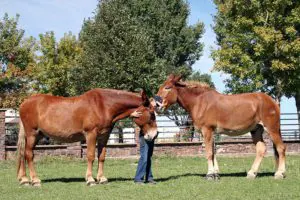 When I was growing up, my grandmother constantly reminded me of the importance of good manners. She would say, “You will never get anywhere of any consequence in this world without good manners!” And she would add, “Without good posture and proper dress, you won’t live long enough to enjoy it!” She made me read Emily Post’s Book of Etiquette from cover to cover. In retrospect, although reading the entire book was a real chore, the respect for good manners that she passed on to me has been an extremely valuable gem in my training experience with equines.
When I was growing up, my grandmother constantly reminded me of the importance of good manners. She would say, “You will never get anywhere of any consequence in this world without good manners!” And she would add, “Without good posture and proper dress, you won’t live long enough to enjoy it!” She made me read Emily Post’s Book of Etiquette from cover to cover. In retrospect, although reading the entire book was a real chore, the respect for good manners that she passed on to me has been an extremely valuable gem in my training experience with equines.
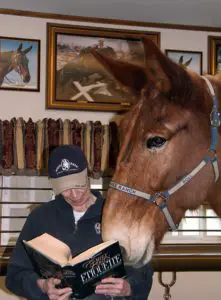 I think that the concept of combining equine training techniques with lessons in good manners is one that many people do not pay as much attention to these days as they probably should. Putting an equine in good posture with respect to his physical comfort is the most obvious form of good manners when communicating with your equine. When you apply the elements of good manners during the training process, you facilitate body and verbal language that equines really appreciate, and when you apply your own good manners and teach good manners to your equine from the very beginning of the training process, you can continue to move forward much more easily than if you do not incorporate good manners between you and your equine. When you run into resistance from your equine, take it as a red flag that you’re missing something in your communication with your animal and change your approach.
I think that the concept of combining equine training techniques with lessons in good manners is one that many people do not pay as much attention to these days as they probably should. Putting an equine in good posture with respect to his physical comfort is the most obvious form of good manners when communicating with your equine. When you apply the elements of good manners during the training process, you facilitate body and verbal language that equines really appreciate, and when you apply your own good manners and teach good manners to your equine from the very beginning of the training process, you can continue to move forward much more easily than if you do not incorporate good manners between you and your equine. When you run into resistance from your equine, take it as a red flag that you’re missing something in your communication with your animal and change your approach.
A common problem equine owners share is catching their equines. One of the elements of good manners that will help you in this task is being considerate toward your equine. When you are considerate about his need to have a routine that he can count on, he will quickly learn to look forward to seeing you at specific times during each day (at the very least, at feeding time in the morning and evening). His anticipation of your visit may appear to be only for the food value. However, when you interact with him at these times, what you say and do will lay the groundwork for your working relationship going forward, the next time you need to catch him, and during lessons. The food reward becomes less important to him over time.
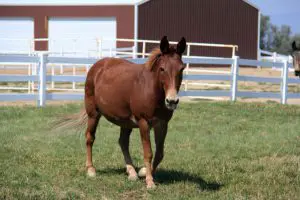 If your equine spends most of his time in the pasture, the good manners of promptness and reliability on your part are critical, as it is the only time you will have during the day to really spend time with him, and he’ll count on you to show up on time each day. What you’ll get out of being prompt at feeding times is a self-discipline that will carry over into everything that you do and will determine whether or not you are a reliable partner in the relationship with your equine. When you feed the oats mixture at night and none in the morning, it gives your equine a reason to come to you after breakfast when you offer oats to catch him, and gives him a reason to come back in off the pasture after being turned out for only a short time in the spring when pasture time needs to be limited. Doing something when it is convenient rather than considering the equine’s need for reliability in the trainer is a recipe for chaos and causes anxiety in both the equine and the trainer. However, having a predictable structure to your routine will allow both you and your equine to remain calm and clear in your communication with each other.
If your equine spends most of his time in the pasture, the good manners of promptness and reliability on your part are critical, as it is the only time you will have during the day to really spend time with him, and he’ll count on you to show up on time each day. What you’ll get out of being prompt at feeding times is a self-discipline that will carry over into everything that you do and will determine whether or not you are a reliable partner in the relationship with your equine. When you feed the oats mixture at night and none in the morning, it gives your equine a reason to come to you after breakfast when you offer oats to catch him, and gives him a reason to come back in off the pasture after being turned out for only a short time in the spring when pasture time needs to be limited. Doing something when it is convenient rather than considering the equine’s need for reliability in the trainer is a recipe for chaos and causes anxiety in both the equine and the trainer. However, having a predictable structure to your routine will allow both you and your equine to remain calm and clear in your communication with each other.
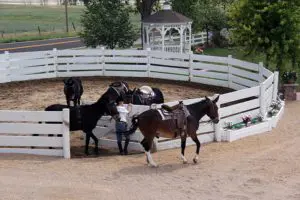 If you want your equine to come to you, rather than chasing him, simply stand at the gate or doorway and ask him to come to you, offering the oats reward when he does. If you are kind, patient and consistent, he will most likely always oblige you.
If you want your equine to come to you, rather than chasing him, simply stand at the gate or doorway and ask him to come to you, offering the oats reward when he does. If you are kind, patient and consistent, he will most likely always oblige you.
Put on the halter politely, being careful not to make any abrupt moves and always being protective of his ears. Before you exit the pen or stall, give him a reward of oats for standing still and waiting for you to finish putting on the halter. Then give him another mouthful, which will keep him busy so you can exit the pen before he does. This teaches him to always stop and wait for your invitation to exit any area. Now he is learning the good manners of allowing you to go through any gates first, and the chances of his becoming a bully will be greatly lessened. When you have multiple animals in a pen and want only one at a time through the gate, just be sure to reward 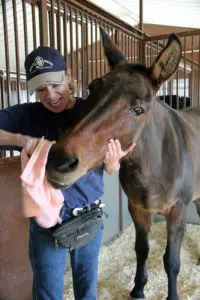 the others for standing back after you have rewarded the one you want for allowing you to halter him. This will also avoid anxiety in the one you are haltering, because he knows you will protect him and wave back the others who might otherwise crowd him or kick at him. The ones you wave back will learn that if they comply, a reward is coming.
the others for standing back after you have rewarded the one you want for allowing you to halter him. This will also avoid anxiety in the one you are haltering, because he knows you will protect him and wave back the others who might otherwise crowd him or kick at him. The ones you wave back will learn that if they comply, a reward is coming.
During grooming, be polite and considerate about how you touch your animal over every part of his body. Pay special attention to sensitive areas (which is a part of imprinting), how you use your grooming tools regarding pressure over bones and around sensitive areas, and how much disciplinary pressure can be applied if your equine becomes agitated and uncooperative. This is the way to sensitize him to communicate with his trainer. When you are polite and considerate, your animal will learn to trust you and be curious rather than afraid of what is going to happen next. If he paws and shows anxious behavior, ask him to stand still only when you are directly working on him, and then allow him expression of his anxiety in between times. If you pay attention to these negative behaviors, they will only escalate, but when you don’t react to the anxious behaviors he may show at times, the behaviors will eventually subside with age and maturity.
Don’t expect to be able to control your equine’s vocal expressions. Allow him his vocal expression and feel free to engage in the “discussion” he is initiating. Eventually, his vocal expressions will become predictable (upon your approach, answering your responses, at feeding time, etc.) because you acknowledge his polite vocal requests for attention.
 Being in good posture feels good to all of us and allows all the organs in the body to work correctly. When one is comfortable and amply prepared for physical activity, it is always more enjoyable. This is no different for equines. When you don’t consistently pay attention to your own good posture, neither will your equine pay attention to his. His movements will tend to be difficult and unpleasant, and the relationship between the two of you may begin to erode. But when your equine is encouraged to be in good posture during training, it feels good to him and, over time, will become his normal way of moving and resting. He will also be grateful for your kindness and consideration, and he will look forward to the activities he gets to do and the time he spends with you. When you pay attention to your own good posture right from the beginning of leading training and every time you work with your equine, he will be able to mirror your good posture. The result will be his own good posture, which will result in more comfort for him.
Being in good posture feels good to all of us and allows all the organs in the body to work correctly. When one is comfortable and amply prepared for physical activity, it is always more enjoyable. This is no different for equines. When you don’t consistently pay attention to your own good posture, neither will your equine pay attention to his. His movements will tend to be difficult and unpleasant, and the relationship between the two of you may begin to erode. But when your equine is encouraged to be in good posture during training, it feels good to him and, over time, will become his normal way of moving and resting. He will also be grateful for your kindness and consideration, and he will look forward to the activities he gets to do and the time he spends with you. When you pay attention to your own good posture right from the beginning of leading training and every time you work with your equine, he will be able to mirror your good posture. The result will be his own good posture, which will result in more comfort for him.
Being in good posture is not a natural thing for anyone—humans or equines—it must be consciously learned. So through self-discipline, you as the trainer, become the role model for the equine. When you work together like this, you both learn to be in good posture. However, if you are not in good posture, then it will adversely affect both of you, and your equine will be unable to find his own good posture, which will in turn, negatively affect his performance. In order for training to go forward smoothly from one step to the next, both you and your equine need to learn how to walk in good posture.
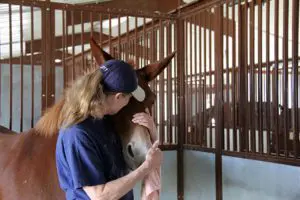 There will be times when it is necessary to employ negative reinforcement to stop bad behaviors that can escalate and become truly dangerous behaviors before they become persistent and uncontrollable. These corrections, which are covered in DVD #2 of my Training Mules and Donkeys series, are the equivalent of a firm and definite “No!” and help define the boundaries of your relationship with your equine. When boundaries are not clearly set, the result is disrespect from your animal, but when boundaries are clearly set and are consistently maintained right from the start, the incidence of bad behavior from your equine is greatly reduced.
There will be times when it is necessary to employ negative reinforcement to stop bad behaviors that can escalate and become truly dangerous behaviors before they become persistent and uncontrollable. These corrections, which are covered in DVD #2 of my Training Mules and Donkeys series, are the equivalent of a firm and definite “No!” and help define the boundaries of your relationship with your equine. When boundaries are not clearly set, the result is disrespect from your animal, but when boundaries are clearly set and are consistently maintained right from the start, the incidence of bad behavior from your equine is greatly reduced.
It is critical for your equine to break things down into very do-able steps for which he can be rewarded. For the best and safest results in this kind of equine training and management, it is vitally important that you use good manners yourself to teach your equine good manners, and employ both good manners and good posture throughout your entire relationship with your equine. If you always practice good manners when communicating with your equine, you might even get a “Head Hug!”
To learn more about Meredith Hodges and her comprehensive all-breed equine training program, visit LuckyThreeRanch.com, MEREDITH HODGES PUBLIC FIGURE Facebook page, or call 1-800-816-7566. Check out her children’s website at JasperTheMule.com. Also, find Meredith on Pinterest, Instagram, MeWe, YouTube and Twitter.
Covered in TRAINING MULES & DONKEY: A LOGICAL APPROACH TO TRAINING, TRAINING WITHOUT RESISTANCE, EQUUS REVISITED and A GUIDE TO RAISING & SHOWING MULES at www.luckythreeranchstore.com.
© 2013, 2015, 2016, 2024 Lucky Three Ranch, Inc. All Rights Reserved.




